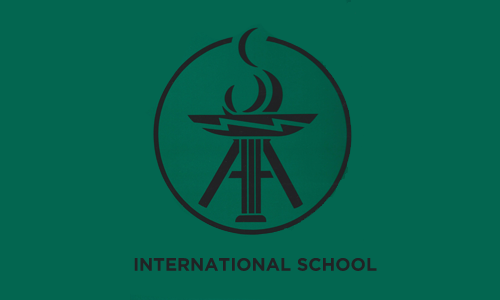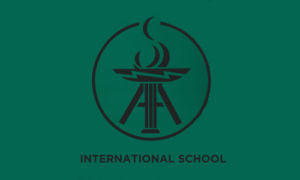Education blew in and took its seat in the classrooms along the breezeway still scattered with flaking chips of paint. It was the first day of school. It was the first day of a school.
…It’s a real mix of students, drawn from nearly every elementary and middle school in the district. One-third of the students have special needs, ranging from the academically gifted to those with behavioral and learning disabilities. There are a mildly mentally retarded student, a couple of transitional [ESL] students and a student quite mobile in his wheelchair. Twenty of the students are Asian, African-American, Latino or Asian American.
–Mary E. Cronin, Seattle Times
History of Bellevue International School:
The Bellevue International School program was envisioned and developed by six veteran teachers.*
Our goal was to discover whether a school could be created that would be a joy to work in, as well as produce superb learning results for students.
The six of us met for a year on our own time, and on half time release prior to opening the school.
During that year and a half, we hammered out a vision for a 6-12 school that would raise the level of participation, accountability and success for all students.
We made a presentation of our vision to the Bellevue School District Board, and asked for the go-ahead.
Although board members were enthusiastic about our ideas, they challenged us to seek external validation for our concept. Six months later, we six returned with a $300,000 Schools for the 21st Century Grant from the State of Washington: one of twelve recipients from 113 schools that had applied.
Unlike the other applicants, we were awarded the grant based upon the promise of our design and core values. Unlike our competitors–all of which were schools already in existence– we had no students, we had no building, and we had yet to write curriculum.
At the next Board meeting our proposal was enthusiastically approved, despite district level administrator doubt and wide-spread district teacher resistance.
That spring our Bellevue International School team was given an unused elementary school as our site: a building that was also being used as a district warehouse and as a food-bank. A suburban educational “favela” to be sure; but we six were ecstatic, and now the pressure was on.
We were left on our own to develop the program, write a curriculum, equip a building, and then recruit families and students who were willing to take a risk on an untried idea. We had six months to to be up and ready.
I can’t begin to describe the sense of obligation–and isolation–that we felt at the time. We were moving from the realm of being teachers safely tucked away in regular classrooms to becoming designers of a new school in which parents would place their children and their trust.
Such high flying carried with it a high potential for failing to fly: forever after, as individual teachers and program developers, we would take the credit or the blame for the quality of the program that we envisioned and created.
A semester of intensive planning led us to a widely publicized launch sequence.
Our first Bellevue International School recruitment and information meeting, held in 1991 on the night of “Desert Storm,” brought a grand total of three parents and one student. But the next, held two weeks later, brought an overflow crowd that was eager to hear about new schooling choices. As word spread, we were on our way to getting the 150 students that we needed in order to open in the Fall of 1991.
During those early meetings our teacher team described a Bellevue International School program where student centering, skill acquisition, growth and inquiry were the standard.
Our emphasis was not on content mastery alone, but also on what we called the “metacurricular” aspect of an effective school: students learning how to participate, how to ask questions, how to apply new knowledge and skill in meaningful ways–all supported by a staff ethos of interrogative modeling, well designed activities, relentless checking for understanding, and student-centering that created numerous opportunities for discovery and success.
Yes, we were doing the Common Core two decades before the old standards were dressed up in the language of the “new” Common Core.
As a 6-12 school of choice, we accepted all students who applied, and final enrollment decisions at Bellevue International were based upon a lottery.
The founding of Bellevue International occurred in the earliest days of the small schools movement–a movement based upon the belief that elements of the teaching & learning equation needed to be re-examined if public schools were to be renewed.
As co-founders and program developers of Bellevue International, we knew that our success in improving upon the large high school model would depend upon instituting key “second order” changes that went to the heart of the educational endeavor.
Deep level transformation was our goal, and our first task would be to create an articulated, essential curriculum that deliberately targeted fundamental skills, and that provided continuity of learning experiences over the years. But in order for this to be accomplished, staff in each content area at Bellevue International School would have to identify and commit to referencing all classroom activities to a common core of “essential questions” and skill practices that would underlie all learning activities, as well as link them forward through the years (see Building a Powerful Teaching Culture).
Because of our cumulative experience in large American high schools, we also knew that we would have to consistently uphold the same performance standards and behavioral expectations for all students. In order to create a school culture where exploration, scholarship and respectful participation were the norm, all teachers needed to be on the same page.
As master practitioners, we knew that each teacher would be expected to model and reinforce those scholarly “habits of mind” that would be the key to student participation and success in each content area and level.
There could be no weak link in the chain; no inconsistency as to “what we were about, and what we cared about.”
Like our counterparts in other areas of the country, we teacher founders of Bellevue International believed that our children’s schools needed to be re-dedicated to high academic standards; that our schools needed to bring an end to social promotion ; and that coherent curriculum, arts, foreign language proficiency, and oustanding teacher instructional skill would be the essential ingredients for our school’s success.
Our vision was not about separating the gifted from those who were struggling.
Instead we planted ourselves firmly within the arena of public education and proclaimed that all students can learn, and that all students can achieve.
The key to Bellevue International’s early success: united staff commitment to a strong school culture, superb instructors, and a curriculum design that targeted student performance proficiencies while pursuing essential questions that knit together all learning experiences.
By the time we graduated our first Bellevue International School class in 1997, our lottery waiting list had grown to several hundred students, and our state and national test scores indicated that we were heading in the right direction.
The Bellevue International mascot, the “Titan”, was selected by students at the end of the first year. The official logo, a Greek tripod with an ascending flame, was designed by Mt. Vernon artist (and brother in law) Doug Dore.

The tripod logo spells out the word “Titans” in this fashion: The “T’s” and “I” are formed by the two vertical and horizontal lines that are the center leg and the cauldron base; the “A” is formed by the outer legs upon which the tripod stands; the “N” is formed by the zig-zag thunderbolt that slashes across the tripod rim; and the “S” is formed by the flame that rises skyward.
As students understood, Prometheus was the heroic Titan who journeyed to Olympus to capture a bit of Zeus’s jealously guarded sacred fire, then carried an ember back to earth where he gave it to a shivering, abject humanity. The gift that Prometheus brought was knowledge and power, and he was punished for this transgression by a tyrannical Zeus who chained him to Mt. Caucausus–we all know the rest of that story as well.
Both the logo and the mission of our school complemented each other in this way: We wished to share the spirit and gift of Prometheus with all of our students. Our goal was to imbue them with the confidence and courage to know, to rise above, to explore, to challenge, and to acquire the power to contribute to the well-being of themselves and others.
*Bellevue International School’s Founders were: Rick Hart, Patricia McLean, Rita Lowy, Terry LaRussa Banton, Karen Kurle and Bruce Saari. Of these six founders, only four assumed teaching positions when the school opened: McLean, Lowy, LaRussa Banton and Saari. Hart assumed administrative duties at the District level, and Kurle was not available to teach because of an upcoming leave. Additional staff hired for our first year included Kevin Finnegan (Science), Carol Schmidt (International Sudies & German), and Kay Marsh (Math). Marty Ediger was the Office Manager.
***

